Immediate and delayed consequences of xanomeline wash-resistant binding at the M3 muscarinic receptor
- PMID: 19082883
- PMCID: PMC3752336
- DOI: 10.1007/s11064-008-9886-3
Immediate and delayed consequences of xanomeline wash-resistant binding at the M3 muscarinic receptor
Abstract
Xanomeline is thought to be a M1/M4 functionally selective agonist at muscarinic receptors. We have previously demonstrated that it binds in a unique manner at the M1 receptor. In the current study, we examined the ability of xanomeline to bind to the M3 receptor and determined the long-term consequences of this mode of binding in Chinese hamster ovary cells expressing M3 receptors. Xanomeline binds in a reversible and wash-resistant manner at the M3 receptor and elicits a functional response under both conditions. Long-term exposure to xanomeline resulted in changes in the binding profile of [(3)H]NMS and a decrease in cell-surface receptor density. Additionally, pretreatment with xanomeline was associated with antagonism of the functional response to subsequent stimulation by conventional agonists. Our results indicate that xanomeline binds to and activates the M3 muscarinic receptor in a wash-resistant manner, and that this type of binding results in time-dependent receptor regulation.
Figures

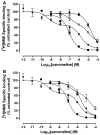

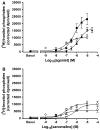
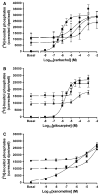
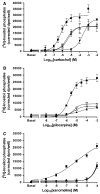
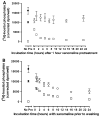
Similar articles
-
Mechanisms of M3 muscarinic receptor regulation by wash-resistant xanomeline binding.Pharmacology. 2009;83(5):301-17. doi: 10.1159/000214843. Epub 2009 Apr 28. Pharmacology. 2009. PMID: 19401618 Free PMC article.
-
Persistent binding and functional antagonism by xanomeline at the muscarinic M5 receptor.J Pharmacol Exp Ther. 2005 Oct;315(1):313-9. doi: 10.1124/jpet.105.090134. Epub 2005 Jul 7. J Pharmacol Exp Ther. 2005. PMID: 16002459
-
Long-term changes in the muscarinic M1 receptor induced by instantaneous formation of wash-resistant xanomeline-receptor complex.J Pharmacol Exp Ther. 2007 Dec;323(3):868-76. doi: 10.1124/jpet.107.129940. Epub 2007 Sep 12. J Pharmacol Exp Ther. 2007. PMID: 17855477
-
Xanomeline and the antipsychotic potential of muscarinic receptor subtype selective agonists.CNS Drug Rev. 2003 Summer;9(2):159-86. doi: 10.1111/j.1527-3458.2003.tb00247.x. CNS Drug Rev. 2003. PMID: 12847557 Free PMC article. Review.
-
Importance and prospects for design of selective muscarinic agonists.Physiol Res. 2008;57 Suppl 3:S39-S47. doi: 10.33549/physiolres.931449. Epub 2008 May 13. Physiol Res. 2008. PMID: 18481916 Review.
Cited by
-
Mechanisms of M3 muscarinic receptor regulation by wash-resistant xanomeline binding.Pharmacology. 2009;83(5):301-17. doi: 10.1159/000214843. Epub 2009 Apr 28. Pharmacology. 2009. PMID: 19401618 Free PMC article.
-
Drug Design Targeting the Muscarinic Receptors and the Implications in Central Nervous System Disorders.Biomedicines. 2022 Feb 7;10(2):398. doi: 10.3390/biomedicines10020398. Biomedicines. 2022. PMID: 35203607 Free PMC article. Review.
-
Involvement of a subpopulation of neuronal M4 muscarinic acetylcholine receptors in the antipsychotic-like effects of the M1/M4 preferring muscarinic receptor agonist xanomeline.J Neurosci. 2011 Apr 20;31(16):5905-8. doi: 10.1523/JNEUROSCI.0370-11.2011. J Neurosci. 2011. PMID: 21508215 Free PMC article.
References
-
- Caulfield MP, Birdsall NJ. International union of pharmacology Xvii. Classification of muscarinic acetylcholine receptors. Pharmacol Rev. 1998;50:279–290. - PubMed
-
- Wess J. Muscarinic acetylcholine receptor knockout mice: novel phenotypes and clinical implications. Annu Rev Pharmacol Toxicol. 2004;44:423–450. 10.1146/annurev.pharmtox.44.101802. 121622. - PubMed
Publication types
MeSH terms
Substances
Grants and funding
LinkOut - more resources
Full Text Sources

